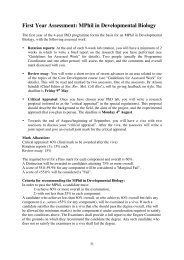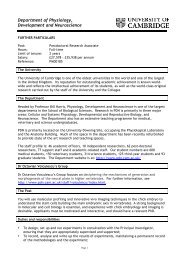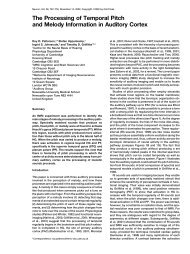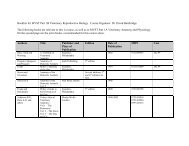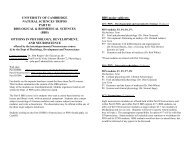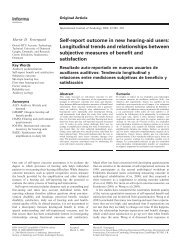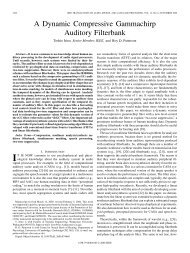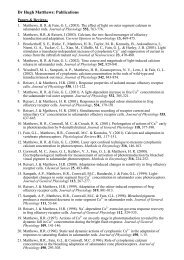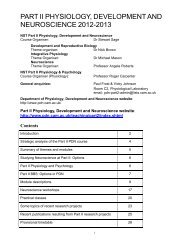FRIDAY MORNING, 20 MAY 2005 REGENCY E, 8:30 A.M. TO 12:00 ...
FRIDAY MORNING, 20 MAY 2005 REGENCY E, 8:30 A.M. TO 12:00 ...
FRIDAY MORNING, 20 MAY 2005 REGENCY E, 8:30 A.M. TO 12:00 ...
You also want an ePaper? Increase the reach of your titles
YUMPU automatically turns print PDFs into web optimized ePapers that Google loves.
<strong>FRIDAY</strong> <strong>MORNING</strong>, <strong>20</strong> <strong>MAY</strong> <strong>20</strong>05<br />
BALMORAL, 8:15 A.M. <strong>TO</strong> <strong>12</strong>:<strong>00</strong> NOON<br />
Session 5aMU<br />
Musical Acoustics: String Instrument Design and Construction<br />
Thomas D. Rossing, Cochair<br />
Physics Dept., Northern Illinois Univ., De Kalb, IL 60115<br />
Christopher E. Waltham, Cochair<br />
Dept. of Physics and Astronomy, Univ. of British Columbia, 6224 Agricultural Rd., Vancouver, BC V6T 1Z1, Canada<br />
Invited Papers<br />
8:15<br />
5aMU1. Acoustical considerations in the design—and re-design—of the violin. Joseph Curtin Joseph Curtin Studios, 3493 W.<br />
Delhi, Ann Arbor, MI 48103, violins@josephcurtinstudios.com<br />
The violin is a highly evolved instrument which has long resisted significant changes to its design and construction. Still,<br />
acoustical research over the past several decades has shed sufficient light on the workings of the violin that makers can now consider<br />
non-traditional approaches to their craft in order to optimize the sound, playability, and consistency of their instruments. The work of<br />
researchers such as Duennwald, Haines, Hutchins, and Weinreich will be considered in terms of its usefulness as a guide to building<br />
better violins.<br />
8:40<br />
5aMU2. The violin octet and bowed string instrument design. George Bissinger Phys. Dept., East Carolina Univ., Greenville,<br />
NC 27858<br />
Modal analyses were combined with room-averaged acoustic measurements of a complete octet to assess Schellengs fundamental<br />
scaling design assumptions: similarity of shape and flat plate scaling. The scaling employed only the two lowest strongly radiating<br />
violin resonances, the main air A0 and main wood comprised of the first corpus bending modes B1 and B1 . A0 fell below the<br />
desired pitch placement (1.5 lowest string pitch, while the B1 complex generally straddled the desired placement at 2.25.<br />
Difficulties in properly scaling A0 derived partly from an unreliable theory that failed to incorporate A0 coupling to A1 first<br />
length-wise cavity mode, and partly from inability to incorporate cavity wall compliance. Wall compliance dropped A1 into main<br />
wood region even though larger instruments were designed successively shorter; the A1/A0 frequency ratio rose from 1.5 to 2.0<br />
smallest to largest. Modern models sensitive to cavity shape predict A0 and A1 within 10% over the octet, ranging over 4.5:1<br />
in length, 10:1 in f -hole area, 3:1 in top plate thickness, and <strong>12</strong>8:1 in volume. A0 radiates strongly over the octet, while<br />
surprisingly A1 is the dominant radiator in the main wood region for the large bass even though A1 was never included in the scaling.<br />
9:05<br />
5aMU3. The acoustics of hammered dulcimers. David R. Peterson Dept. of Mathematics, Univ. of Central Arkansas, Conway,<br />
AR 7<strong>20</strong>35, DavidP@uca.edu<br />
The hammered dulcimer, a stringed instrument played with two wooden hammers, probably originated in the Middle East, but it<br />
has become part of the musical culture of many countries. In the U. S., the folk revivial in the 1970’s sparked renewed interest in the<br />
hammered dulcimer as a concert instrument. Today, despite some consolidation in the retail market, there are still hundreds of<br />
builders, mostly amateurs, who experiment with the basic design. The most important design parameters will be discussed from a<br />
practical and acoustical point of view: soundboard size, shape, and composition, internal bracing, bridge shape, string arrangement and<br />
composition, hardness of bridge caps, hammer weight and stiffness, instrument resonances due to the unique string splitting and<br />
stiffness of the body, and soundboard modes.<br />
9:<strong>30</strong><br />
5aMU4. Classical guitar construction: The acoustician’s tale. Bernard E. Richardson School of Phys. and Astron., Cardiff Univ.,<br />
5 The Parade, Cardiff CF24 3YB, UK, RichardsonBE@cardiff.ac.uk<br />
The vast majority of guitars produced today are built according to general principles laid down in the nineteenth century.<br />
Nevertheless, the devil is in the detail, and innovative makers constantly reappraise the design and construction of instruments in their<br />
endeavors to control quality or to seek ‘‘improvement.’’ The maker’s approach, necessarily, tends to be pragmatic, but it is one which<br />
can be greatly informed by the application of relatively simple acoustical models. This paper will examine various important design<br />
aspects—for example choice of materials, body size, strutting, soundboard thickness—introducing the basis for making informed<br />
decisions.<br />
5a FRI. AM<br />
2589 J. Acoust. Soc. Am., Vol. 117, No. 4, Pt. 2, April <strong>20</strong>05 149th Meeting: Acoustical Society of America 2589



